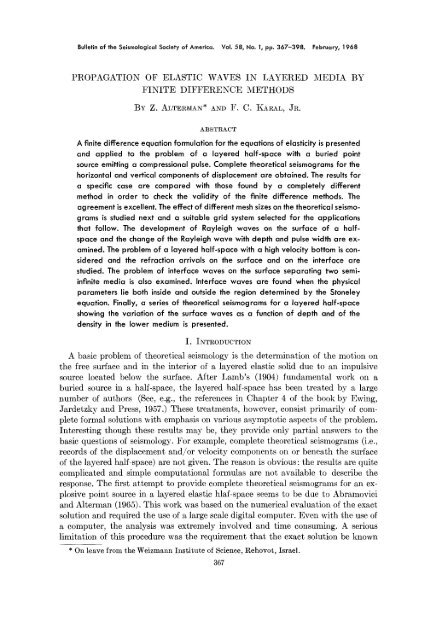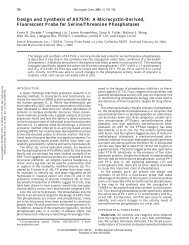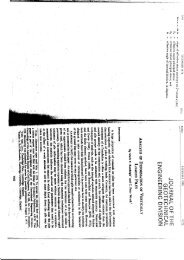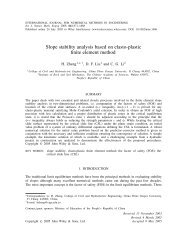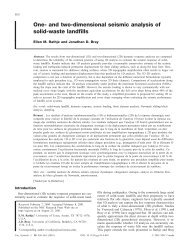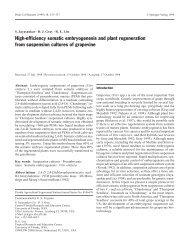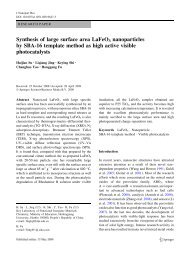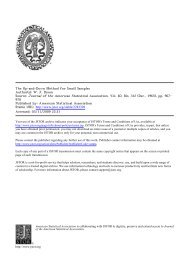PROPAGATION OF ELASTIC WAVES IN LAYERED MEDIA BY ...
PROPAGATION OF ELASTIC WAVES IN LAYERED MEDIA BY ...
PROPAGATION OF ELASTIC WAVES IN LAYERED MEDIA BY ...
Create successful ePaper yourself
Turn your PDF publications into a flip-book with our unique Google optimized e-Paper software.
Bulletin of the Seismological Society of America. Vol. 58, No. 1, pp. 367-398. February, 1968<strong>PROPAGATION</strong> <strong>OF</strong> <strong>ELASTIC</strong> <strong>WAVES</strong> <strong>IN</strong> <strong>LAYERED</strong> <strong>MEDIA</strong> <strong>BY</strong>F<strong>IN</strong>ITE DIFFERENCE METHODS<strong>BY</strong> Z. ALTERMAN* AND F. C. KARAL, JR.ABSTRACTA finite difference equation formulation for the equations of elasticity is presentedand applied to the problem of a layered half-space with a buried pointsource emitting a compressional pulse. Complete theoretical seismograms for thehorizontal and vertical components of displacement are obtained. The results fora specific case are compared with those found by a completely differentmethod in order to check the validity of the finite difference methods. Theagreement is excellent. The effect of different mesh sizes on the theoretical seismogramsis studied next and a suitable grid system selected for the applicationsthat follow. The development of Rayleigh waves on the surface of a halfspaceand the change of the Rayleigh wave with depth and pulse width are examined.The problem of a layered half-space with a high velocity bottom is consideredand the refraction arrivals on the surface and on the interface arestudied. The problem of interface waves on the surface separating two semiinfinitemedia is also examined. Interface waves are found when the physicalparameters lie both inside and outside the region determined by the Stoneleyequation. Finally, a series of theoretical seismograms for a layered half-spaceshowing the variation of the surface waves as a function of depth and of thedensity in the lower medium is presented.I. <strong>IN</strong>TRODUCTIONA basic problem of theoretical seismology is the determination of the motion onthe free surface and in the interior of a layered elastic solid due to an impulsivesource located below the surface. After Lamb's (1904) fundamental work on aburied source in a half-space, the layered half-space has been treated by a largenumber of authors (See, e.g., the references in Chapter 4 of the book by Ewing,Jardetzky and Press, 1957.) These treatments, however, consist primarily of completeformal solutions with emphasis on various asymptotic aspects of the problem.Interesting though these results may be, they provide only partial answers to thebasic questions of seismology. For example, complete theoretical seismograms (i.e.,records of the displacement and/or velocity components on or beneath the surfaceof the layered half-space) are not given. The reason is obvious: the results are quitecomplicated and simple computational formulas are not available to describe theresponse. The first attempt to provide complete theoretical seismograms for an explosivepoint source in a layered elastic hlaf-space seems to be due to Abramoviciand Alterman (1965). This work was based on the numerical evaluation of the exactsolution and required the use of a large scale digital computer. Even with the use ofa computer, the analysis was extremely involved and time consuming. A seriouslimitation of this procedure was the requirement that the exact solution be known* On leave from the Weizmann Institute of Science, Rehovot, Israel.367
370 BISLLET<strong>IN</strong> <strong>OF</strong> THE SEISMOLOGICAL SOCIETY <strong>OF</strong> AMERICAeq. (1) may be writtenar~ + r Or r" + arazj + \ L Oz. arazj v3 at ~(~)az~ +r-~ + azarj + ~ L ar2O2A 10A 1 OB] _ 1 O2B (4)azar r az + r-~:r J vo 2 at 2whereVc = [(X -~- 2tt)/p] 1/2vo = [E41/2. (5)v~ is the eompressional speed and v.~ is the shear speed of the medium. In the discussionthat follows, when superscripts 1 and 2 are attached to the quautities A andB, they refer to media 1 and 2, respectively. Elastic velocities in the two mediaare distinguished by subscripts.The boundary conditions for the problem are determined by the fact that thestresses must vanish on the free surface, and that both stresses and displacementsmust be continuous at the interface. The normal and tangential stresses across theplane surface z - const, can be expressed in terms of the displacement components asOA 1 A + OBT== (X+2~) -~:r -t-r ~zz --2~ n+-~lab OA] (6)~.=~ ~:r+-~z •Hence the boundary conditions at the free surface z = 0 are given byoA 1 A1 0B:l (Vsl~2 [I A I oA1 l~:-r +- + az j - 2 -- + =0r \v~/ Or JThe boundary conditions at the interface z = h are given by[OA 1 1A~ abel_ (v~2[!A~ OA11Or + - + az j 2 +r \v~:! Or Jar + az J O. (7)\yell L ar + 7 + az j 2 Pll \Vcl/ ar Jar + az J ~ L ar + az J (9)
<strong>PROPAGATION</strong> <strong>OF</strong> <strong>ELASTIC</strong> <strong>WAVES</strong> <strong>IN</strong> <strong>LAYERED</strong> <strong>MEDIA</strong> 371A 1 = A 2 (10)B 1 = B 2. (11)A point source of compressioaal waves is located inside the layer along the axisat the point (0, d). We select a disturbance satisfying the elastic equations ofmotion (1) and having the appropriate singularity at the source. The source startsat the time t -- 0, causes a variation in stress during a finite time interval, and then(UR)MA xl-ZhlI,I0J0..,{])(UR)cONST-7-/2/,I 2\4Vcl A-F d-I, -- Vc,tFIG. 2. Time variation of the radial displacement UR for a point compressional source in ahomogeneous elastic medium.leads to a constant displacement for each particle in the medium for large time(t --+ ~ ). In order to have smooth second derivatives of displacement with respectto time and distance, the displacement potential is defined as the fourth finite differenceof a fourth order polynomial. The displacement potential of the source isdefined by1(I)o(t) = ~[fo(t) -- 4fo(t-- A) --~ 6fo(t-- 2A) -- 4fo(t-- 3A) +fo(t-- 4A)] (12)withfo(t) - 12RC (t - R1)4H(t -- -~1) . (13)Here vc, is the compressional velocity of medium 1, R = [r 2 Jr (z -d)2] 1/2 isthe
372 BULLET<strong>IN</strong> <strong>OF</strong> THE SEISMOLOGICAL SOCIETY <strong>OF</strong> AMERICAspherical distance from the source, C is an amplification factor (dimensions oflength), H is the Heaviside unit function and A is a constant measuring the sharpnessof the pulse. The spherically symmetric displacement ~ is given byz~ = grad ¢0. (14)The source causes a quai~ic increase in radial displacement up to a maximumvalue (uR)m~x which is then followed by a quartic decrease down to a constantvalue (uR) .... t which is obtained after a time 4A. The maximum occurs at the timet .... = R/vcl + 2A. The width 4A is a measure of the sharpness of the pulse. In thelimit of vanishing A, ~0(t) approaches the Heaviside unit function, and uR(t)becomes a delta function followed by a finite step. See Figure 2.III. F<strong>IN</strong>ITE DIFFERENCE FORMULATION(1) Equations of Motion. The equations of motion may be written in finitedifference form by replacing the various derivatives by their centered finite differenceapproximations. If we let r - mar and z = nAz, where Ar and Az are incrementMlengths along the r and z axes, and let t = pAt, where At is an incrementin time, equations (3) and (4) may be written as follows:fvc At~er , -- 2Am ~ p -F A.~-I n p]A .... p+, -- 2A .... p -- A .... p-1 + \--At-r) LAm+l,~,p . . . .1 (V~ Ath21 (v~ Ate2 1+ -2 \--~-] m [Am+~,.,v - Am-l,n,p] - \ Ar ] -~ A ....l (v~At~2(Ar~r I _ (_y][ ~+~,~+~pv. B+ ~ \ Ar / \Az/L \vj j-- Bm+l,n-l,p- Bm-l,.+l,~ + B~-1,~-1,~](v~At'~2(Ar'~2(~'~2[Am,n+l,p- 2A .... ~, 4- A .... -1,p] (15)+ k Ar / \Az] \vJ[vc At'~2(Ar'~2rBB .... p+l = 2B .... p -- B .... P-I + \-~7] \-ffz] .... +~,p -- 2B .... p + Bm,~-l,p]4- ~1 (v~,_A~_]At~2(Ar'~[ I\Az]L_ \~,(vs~21/l[Am'n+l'P Am,n-l,p]-+ 4 ~k~r/ k~Zz,]L Vcc [,m+l,n+l.p -- Am+l ~-1,Am-i,n+i,p Jr- A~n-l,n-l,~]4- ~ \ Ar ] \vJ m [Bm+~,~,p -- Bm-~,n,p]. (16)
<strong>PROPAGATION</strong> <strong>OF</strong> <strong>ELASTIC</strong> <strong>WAVES</strong> <strong>IN</strong> <strong>LAYERED</strong> <strong>MEDIA</strong> 373In the above equations the notation A .... p+~ means the value of the radial displacementat the point (mAr, nAz) for the time (p ~- 1)At. Similar meanings applyto other subscripts attached to the displacement components A and B. m, n, andp take on positive integral values (including zero) only. All derivatives appearingin equations (15) and (16) are correct to second order in the increments appearingin the denominators (e.g., 02A/Ot 2 is correct to order (At) 2, 02B/OrOz is correct toorder (Ar) 2, (Az) 2 or (ArAz), whichever is largest, etc.). Equations (15) and (16)are explicit difference equations. Note that when values of the displacement componentsA and B are known at time levels p - 1 and p, it is possible to computethe displacement at the next time level p -t- 1. The calculation stencil for equation(15) is shown in Figure 3a and the calculation stencil for equation (16) is shown inFigure 3b.l~pt~p,,,. r~FnF~mVALUES <strong>OF</strong> A/~VALUES <strong>OF</strong> Bi @ wz~n IVALUES <strong>OF</strong> A,/~VALUES <strong>OF</strong> BCo)FIG. 3. Calculation stencils for the disp|~cement components. Par~ (a) shows the grid pointsused in c~leulating A, and part (b) shows the grid points used in calculating B.Equations (15) and (16) apply to either medium so long as the stencil does notoverlap the free surface or the interface and the axis of symmetry is excluded(m ~ 0). Along the axis of symmetry (m = 0), equations (15) and (16) areundefined because of the presence of m in the denominator. Valid equations alongthe axis of symmetry are easily derived, however, by using independent arguments.Due to continuity of the elastic media, the radial displacement A is zero alongthe axis of symmetry. HenceA0,~.p+~ = 0. (17)The normal displacement B is more complicated. The terms causing trouble in theequation for B are (1/r)(OA/Oz) and (1/r)(OB/Or). By using L'Hopital's rule,the term (1/r)(OA/Oz) can be replaced by 02A/OrOz and (1/r)(OB/Or) can bereplaced by 02B/Or 2. These, in turn, can be replaced by their finite difference approxinmtions.A and B are defined for r >= 0 only. Due to their regularity nearr = 0, they can be continued to r < 0 by using the symmetry conditionsA-1,~,p = -Al,~,pB-I,~.~ = +BI,~,~. (18)(b)
(19)374 BULLET<strong>IN</strong> <strong>OF</strong> THE SEISMOLOGICAL SOCIETY <strong>OF</strong> AMERICAIf we make these new substitutions in the equation of motion for B, thenBo,n,p-}-i ~- 2Bo,n,p -- Bo,n,p-1 .Jr_ k__~.._r ] k~z} [/~0,n+l,p --ZBo,n,p ~- Bo,n-l,p]+ 2 \ Ar ] \Az/L v~ [A~,,,+~,p -- A~,,,-,,~]+ 2 -Bo,.,.l.Equations (15)-(17) and (19) are the basic formulas used in our computations.We have carried out a standard stability study and find an approximate stabilitycriterion is given byAr /
<strong>PROPAGATION</strong> <strong>OF</strong> <strong>ELASTIC</strong> <strong>WAVES</strong> <strong>IN</strong> <strong>LAYERED</strong> <strong>MEDIA</strong> 375(22) are for n = --1 and therefore correspond to a fictitious line above the actualphysical surface at n = 0. See Figure 4.A complication arises on the axis of symmetry (m = 0) and special treatment isrequired. Due to continuity and cylindrical symmetry,A 1 0,-1,p = 0 (23)as in equation (17).An expression for B 10,-1,p can be found by using equation (6) for r,~ = 0 and replacingthe troublesome term (1/r)A ~ by OA1/Or in the same way as was done for theImTIim m+l_-: rn=-I (FICTITIOUS L<strong>IN</strong>E)n=O (FREE BOUNDARY)n=lD<strong>ELASTIC</strong>MEDIUMZFIG. 4. Grid arrangement at the surface z = 0 showing the fictitious line and free boundary.equations of motion. Then we have\Ar/L \~/ _1 Al,o,p(24)where we use the symmetry condition A -1,~,p 1 = -Al,~,p. t Equations (21)-(24)make it possible at any given time level to compute values of A and B on thefictitious line n = --1. Knowing values on this line, it is then possible to use theequations of motion (15)-(17) and (19) up to and on the actual physical surface~ ~ 0.(3) Interface Boundary Conditions. The boundary conditions that must be satisfiedat the interface z = h are given by equations (8)-(11). In order to obtain anexplicit finite difference computational scheme, we first add a fictitious line tomedium 1 by extending the z-grid beyond the interface at z = h. A fictitious line isnot introduced in medium 2. The media have the interface z = h in common. Inmedium 1, however, the interface is the next-to-last line in that medium while thefictitious line is the last line. In medium 2, the interface is the first line of the z-gridin that medium. See Figure 5a. We now illustrate the procedure for equation (9).Replace the r-derivatives with a centered (two-sided) finite difference approximationand the z-derivatives with an asymmetrical (one-sided) finite difference
376 BULLET<strong>IN</strong> <strong>OF</strong> THE SEISMOLOGICAL SOCIETY <strong>OF</strong> AMERICA(<strong>IN</strong>TERFACE)UPPERMEDIUMn=N-In=Nm-In=N+l -- 4- -I-tI, !-m-':' IIIII---1I. . . . III=-rn= I (<strong>IN</strong>TERFACE)n=2n=3LOWERMEDIUM(a)UPPERMEDIUM*(<strong>IN</strong>TERFACE)n:N-2 -- -n=N-In=Nm-III . . . . .Irn m+ln=l~r n---2---I-- - --IIIIIIIIIin=3LOWERMEDIUMZ(b)FzG. 5. Grid arrangement at the interface z = h. Part (a) shows the grid points used whenthe upper medium is extended to include an additional fictitious line below the interface, andpart (b) shows the grid points used when the lower medium is extended to include an additionalfictitious line above the interface.approximation. Equation (9) then becomes1 B 1 1 1 A 1 A 12~r [ .~+I,N,~ - Bm-I,N,~] + ~ [ m,~+l,~ -- m,~,~](#~)I1 2 B 2 1 A~ A2 1= ~ (B~+1,1,, - ~-~,1,,) + ~ ( ,~,~,,- ,~,~,,) • (25)
<strong>PROPAGATION</strong> <strong>OF</strong> <strong>ELASTIC</strong> <strong>WAVES</strong> <strong>IN</strong> <strong>LAYERED</strong> <strong>MEDIA</strong> 377The notation involving the second subscript on A and B is important. In medium 1,the subscripts N and N 4- 1 indicate the interface and fictitious line, respectively.In medium 2, the subscripts 1 and 2 indicate the interface and next line beyond theinterface extending into medium 2. From equations (10) and (11), which requirethe continuity of displacement across the interface, we have2 _- A 1Am,l,p m,N,pB m=t=1,1 ~ ,p = B m+l 1 ,N,p •(26)Substituting into equation (25), and solving for A ~ on the fictitious line, we obtainA' [ (::)]A 1 (~)A 2m,N+l,p = 1 -- m,N,p 4- m,2,p1 (~__z~-~rl _ (p,2)] 1 1- 2 \~r/L ~ [B,~+~.N,p-- Bm-~,~-,,]. (27)In a similar way, the other interface condition (equation (8)) gives1 p2 Yc2 B 1 p2 vc2 B 2B.,,N+,,. = E 1- Pl \~J I '~'~'" + m \Vcl--] m,2,p1 A(~r)([ (va~ 2] p¢~) r(v~2,)2 2 (v.2~2]~-~ 1-2 . . . .[ , i 2,]X A,~+l,~v,~, -- A~-LN,p + -A.,,N,p • (28)mAlong the axis of symmetry (m = 0) the values of A and B on the fictitious linebecomeA~,N+~,, = 0 (29)and1 [ p2 vc2 ;1 B~,N,p 4- 02 vc2 ; 2B o,N,I,p--- 1- ~ \Vd--/ _1 Pl \~cl/ B o,2,p(Az)([~ (Vsl~2]- P(~pl)r(vc2]2\~)Cl\vc:/ ._1(t;s2)2]} 1~cl-- 2 1 -- 2 -- Li-- I -- 2 AI,N,,.(30)The special considerations required here have been explained earlier.Note that the determination of A t and B 1 on the fictitious line N 4- 1 at time pmeans that we can compute A 1 and B ~ on the interface at the next time step p 4- 1by using the equations of motion for medium 1. Also, since we can compute A ~ andB ~ on the interface (denoted by n = N in medium 1), we know A 2 and B 2 on the
B~-I,~,~]378 BULLET<strong>IN</strong> <strong>OF</strong> THE SEISMOLOGICAL SOCIETY <strong>OF</strong> AMERICAinterface (denoted by n = I in medium 2) by continuity of displacements (equations(10) and (11)). Hence we can find A 2 and B 2 at the next time step p -P i using theequations of motion for medium 2.Equations (27), (28) and (30) contain the ratios (#2/t~1) and (v~2/v~l)2(p2/pl). Ifthe constants characterizing the two media are quite different, then these ratiosmay be large. The effect of these large ratios is to introduce serious errors and(sometimes) instabilities in the calculations. The reaso~ this occurs is because theone-sided derivative in z introduces an asymmetry in the boundary conditions. Ifwe had used a two-sided or centered derivative in z, the finite difference equationsfor the boundary conditions would be symmetrical. However, the calculation schemeacross the interface would no longer be explicit. When the ratios (t~2/pl) and(v~2/v~) 2(p2/pl) are large, we add the fictitious line to medium 2 (rather than medium1) and then derive lesults for A 2 and B 2 along this fictitious line. See Figure 5b.Proceeding in the same manner as before, we obtain the following results whenm~0:= -A~,l,p 2 # 1(Art) (t~) 1 -- [Bm+l,N,p, i+ ( 1 -- m,.~,p-FP,I 1- Am,N-l,p (31)tt2B 2 pl v~ B 1 pl v~l B 1-- m,N--l,pm,l,p = 1- P22 \f)c2/ I m,N,p + p22 \Vc2/Az 1()\Vc2/ J p2 L\Yc2/X[A 1 A t 2A1 1m-~-l,N,p -- m--l,N,p ~ -- m,N,p •m(32)Along the axis of symmetry (m = 0) we haveI (2( (2(2 pl v~l i Pl v~l 1Boa,. = 1 -- B0,N,p + -- B0,~-l,.\vc2/ j \v~2/A ~ 0,1,p = 0 (33)\v~2/ I ~ L \V~2/ \v~21 j)In comparing equations (27)-(30) with equations (31)-(34), we see that the effectof changing the fictitious line from medium 1 to medium 2 is to invert the ratios(p~/~l) and (vc2/v~l)2(p2/;l) into (~1/~2) and (Vcl/Vc2)2(pl/p2), respectively. In ourcomputational work we use the set of equations for which the ratios are least.(4) Special Treatment of Source. The point compressional source used in our work
<strong>PROPAGATION</strong> <strong>OF</strong> <strong>ELASTIC</strong> <strong>WAVES</strong> <strong>IN</strong> <strong>LAYERED</strong> <strong>MEDIA</strong> 379has an infinite discontinuity at the point (0, d). Therefore, in the neighborhood ofthe source point, the displacement components become very large. These largevalues introduce inaccuracies in the finite differencing near the source since largenumerical changes occur from one grid point to an adjacent grid point. Our firstscheme to avoid this difficulty was to describe a small, fixed, spherical region aboutthe source point and calculate the exact values in this region from the known solutionfor a source in an infinite region. Since the reflected and other contributions areA =A3 ~Al~B=BS÷~t~-\REGION .rr30ugcEIAg,=A -AS8R=8-B,9REG/O,V /Z"1ZFro. 6. Grid arrangement for the point source. In the neighborhood of the source (Region I),the finite difference stencil is used to calculate AR and BR. In the region exterior to the source(Region II), the finite difference stencil is used to calculate A and B.finite and bounded, while the source terms vary at least as 1/R, we expected thereflections and other contributions from the free surface and interface to be small incomparison with the source values. This procedure produced artificial reflectionsfrom the fixed spherical region surrounding the source that were found not to benegligible. The method we finally used was a modification of this scheme. We describeit in the next paragraph.Suppose the source is surrounded by a cylindrical region, a cross section of whichis shown in Figure 6. Denote the interior region, including the inner dotted boundary,by I. Denote the exterior region, including the outer dotted boundary, by II. Inboth regions we can always express the horizontal and vertical displacements A andB as
380 BULLET<strong>IN</strong> <strong>OF</strong> THE SEISMOLOGICAL SOCIETY <strong>OF</strong> AMERICAA = AS + ARB = BS+BR (35)Here AS and BS are the horizontal and vertical displacements due to the sourcealone, and AR and BR are the remaining parts of the horizontal and vertical displacementsdue to all other causes. The values of AS and BS can always be deter-16.0X8.0I£o 4'.o ' ' ' ,4:0 f,,~,/,~-8.016.0n~, 8.0 .~ ,,,z'o 4:o 6.o ,4:.o , t~,/d-8.CFIG. 7. Vertical displacement on the surface of a layered half-space. An impulsive, compressional,point source is located midway between the surface and interface. (p2 = 2/1.21pl ,vc2 = 1.1v~, , v~ = 1.lye, .) The observation point is on the surface at a distance of five-layerthicknesses from the epicenter. The first and second curves correspond to pulse widths of 1.2and 1.6, respectively. Results obtained using finite differences.mined exactly. The values of AR and BR represent reflections and other contributionsfrom the free surface and/or interface and are always bounded. We proceed asfollows: (1) Calculate values of AR and BR in I using the finite difference equationscheme. (2) Calculate vahxes of A and B in II using the finite difference equationscheme. (3) From the calculation of AR and BR in I, calculate A and B along theinner dotted line using equation (35). These values provide the boundary valuesneeded to calculate A and B in II using the finite difference equation scheme.(4) Similarly, from the calculation of A and B in II, calculate AR and BR along the
<strong>PROPAGATION</strong> <strong>OF</strong> <strong>ELASTIC</strong> <strong>WAVES</strong> <strong>IN</strong> <strong>LAYERED</strong> <strong>MEDIA</strong>3S1outer dotted line using equation (35). These values provide the boundary valuesneeded to calculate AR and BR in I using the finite difference equation scheme. Theinitial values for AR and BR in region I, and for A and B in region II; are easily obtained.As long as the pulse has not reached the surface or interface, AR = O, BR = 0and these are the initial values for calculating AR and BR subsequently in region I.Similarly, as long as the pulse has not reached the surface or interface, A = AS,B = BS and these are the initial values for calculating A and B subsequently inregion II.08.04 i~' ' ' ' ' ~ . 5 8 : 0 8 . 5ct/H ~ I \.08~0~~ 3~~ 4~o 41s ~o ~ o-.04,- ct/HF*G. 8. Vertical displacement on the surface of a layered half-space. An impulsive, compressional,point source is located midway between the surface and interface. (p~ = 2/1.21p~ ,vc2 = 1.1vc~ , v,e = 1.1v,~ .) The observation point is on the surface at a distance of five-layerthicknesses from the epicenter. The first and second curves correspond to pulse widths of 1.2and 1.6, respectively. Results computed by Alterman and Abramovici using the analyticsolution.IV. DIscussioN <strong>OF</strong> I~ESULTS(1) Comparison with Earlier Results. Our first goal was to establish that thefinite difference equation scheme derived in Section III gave accurate and reliableresults. The simplest way to carry this out was to compare our numerical resultswith those obtained by a different method for the same problem. Fortunatelythis was possible, since theoretical seismograms for a compressional point sourcelying inside a layered half-space have been obtained by Abramovici and Alterman.The computational technique pertaining to the problem is given in Abramovici andAlterman (1965), and the graphs appear in Abramovici (1965). The method usedby these investigators was to evaluate numerically the exact solution obtained
382 BULLET<strong>IN</strong> <strong>OF</strong> THE SEISMOLOGICAL SOCIETY <strong>OF</strong> AMERICAby splitting the Laplace transform of the solution into rays and using Cagniard'stechnique for taking the inverse of the transform. Their method, which is entirelydifferent from the one used in this paper, offers an excellent independent meansfor checking our calculations.Figure 7 contains the theoretical seismograms we obtained for a eompressionalsource located midway between the surface and interface and having pulse widthsgiven by 4A = 1.2 and 4A = 1.6. Throughout the entire paper all time values in ourtheoretical seismograms, unless specified otherwise, are expressed in terms of thedimensionless variable t(v~l/d), where v~l is the shear velocity in the layer, d is thedepth of the source below the surface (or above the interface), and t is real time.For purposes of comparison with the graphs of Abramoviei we assume that theproperties for the surface layer and lower medium are Xl = m, p2 = (2/1.21)or,v02 = 1.lye1 and v82 = 1.1v,1. Hence vc2 > vc~ > vs~ > v~. The observation point istaken on the surface at a distance of five-layer thicknesses measured from the epicenter.Figure 8 contains the results given in Figure 11 of Abramovici. Note thatthe time values are expressed in terms of the dimensionless variable t(c/H), wherec = va and H is the thickness of the layer. Hence the time values in Figure 8 shouldfirst be multiplied by 2 before maldng any comparison between the two sets oftheoretical seismograms. The physical problem solved by the two different methodsare identical except for the analytical form of the input pulse. In the finite differencecalculation the potential function representing the input pulse was a quartie, as definedin equations (12) and (13), while in the work of the previously mentioned investigators,the input pulse was a quadratic.* We preferred the quartie pulse sincewe had the advantage of being able to use a much coarser grid. In making the comparison,we adjust the input displacements so that the pulse widths are the sameand the maxima occur at the same time. The shape of the curves differs slightly atpoints intermediate between the initial, maximum and end points. The agreementbetween the theoretical seismograms obtained by the two different methods isexcellent.(2) Effect of Different Mesh Sizes. Figure 9 shows a series of curves for threedifferent choices of mesh sizes for a typical layered half-space. A point source ofeompressional waves emitting a pulse of width 4A = 1.6 is located midway betweenthe surface and interface. The properties assumed for the surface layer and lowermedium are Xl = m, p2 = .801, vc~ = 1.5vcl and v~2 = 1.5va. Hence v~2 > v~l >v~2 > v~l. The observations point is on the surface at a distance of two-layer thicknessesmeasured from the epicenter. The first curve in Figure 9 is for a coarse mesh(At = .06, Ar = Az = .2), the second curve is for a medium mesh (At = .03,Ar = Az = .1), and the third curve is for a fine mesh (At = .015, Ar = Az = .05).Throughout the entire paper all distance values, unless specified otherwise, are expressedin terms of the dimensionless variable x/d, where x is real distance. Notethat the time scale on each curve is different because the number of steps used washeld fixed. Otherwise, the theoretical seismograms are the same, that is, they arefor the same input pulse, in the same layered half-space and measured at the sameobservation point. Note that there are some distortions in the amplitudes of some* The potential function for the quadratic is given by ¢0(t) = 1/A2[fo(t) -- 2f0(t -- A) +fo(t -- 2A)], where fo(t) = - (C/2R) (t - (R/v~))2H(t - (R/v,~)).
<strong>PROPAGATION</strong> <strong>OF</strong> <strong>ELASTIC</strong> <strong>WAVES</strong> <strong>IN</strong> <strong>LAYERED</strong> <strong>MEDIA</strong> 383of the reflected pulses in the coarse grid. As a result of the comparison of the threecurves shown in Figure 9, we decided to use the medium grid. The deviation betweenthe results for the medium and fine grids indicates the amount of accuracy in ourcalculations.(3) Rayleigh Wave Series. Figures 10 and 11 show a series of curves for six differentobservation points located along the free surface of a homogeneous half-space.The properties sssumed for the half-space are vcl = V~v,l • A point source of com-8.0ACOARSE GRID× 4.003, AxR 2NrKx~: -BxR 2I, i t,,=,/d4.0 8.0 12.0 16,0 20.08.0& 03 × 4.CMEDIUM GRID, ~ A x R ~v / ? \fv /A-- 2 .o . 6.0 s.o io.o " " - -8.C//~ F<strong>IN</strong>E GRiD%03I4.C,:o 2:03.0--4.'FIG. 9. Horizontal and vertical displacements, denoted by A and B, respectively, on thesurface of a layered half-space. A compressional point source of pulse width 1.6 is located midwaybetween the surface and interface. (p2 = .8pl , v~ = 1.5v~1, v~2 = 1.5v~1 .) Note that in thecurves for the medium grid we use the abbreviation A for A X R 2 to help distinguish betweenthe two displacements. The observation point is on the surface at a distance of two-layerthicknesses from the epicenter. The three curves are for coarse, medium and fine meshes.
384 BULLET<strong>IN</strong> <strong>OF</strong> THE SEISMOLOGICAL SOCIETY <strong>OF</strong> AMERICApression~l waves emitting a pulse of width 4A = .8 is located below the surface. Theobservation points in Figure 10 ~re located on the surface at the epicenter, and atdistances of two and four source depths measured from the epicenter. The observationpoints in Figure 11 are located on the surface at distances of six, eight and tensource depths aw~y from the epicenter. The development of the Rayleigh wave isevident as the observation point is moved along the surface. Note that the ratio of½~trn6.04.0' 2.0LRECEIVERON SURFACE AT PO<strong>IN</strong>TDIRECTLY ABOVE SOURCE- B× R 2XI4.0A×R 2'. ' ' ' 16'0 t vst/a8 0 12.0 .8.0&'~ 4.0%RECEIVER ON SURFACE AT DISTANCE 21~AxR 2B×R eJ 4.0 8.0 120'1610tvs,/@16.0 -12.0 -RECEIVER ON SURFACE AT DISTANCE 4d%8.0-, 4.0-Ax R 2iII12.0_BxR 2, 16' ot vs,/a-4,0 -FIG. 10. Horizontal and vertical displacements on the surface of an elastic half-space. Acompressional point source of pulse width .8 is located below the surface (vcl = %/3v~1). Thethree curves are for observation points located on the surface at the epicenter and at distancesof two- and four-source depths measured from the epicenter.
<strong>PROPAGATION</strong> <strong>OF</strong> <strong>ELASTIC</strong> <strong>WAVES</strong> <strong>IN</strong> <strong>LAYERED</strong> <strong>MEDIA</strong>3S5A to B (i.e., the ratio of horizontal to vertical particle displacement) is approximately.68, the correct theoretical value. Also, the motion is seen to be ellipticallyretrograde by comparing amplitudes of horizontM and vertical displacement.Furthermore, the relative amplitude of the surface wave to the direct wave increasesas expected since the surface w~ve spreads in two dimensions and the other in three.In the first curve in Figure 10, which gives the displacement at the epicenter, a waveappears after the direct wave which is due entirely to the presence of the surface.This is a result of the complete solution of the equations of elasticity. According to20.016.CRECEIVER ON SURFACE AT DISTANCE ~d12.0~/ 8.0aJ ~% 4.012,0IA×R 2,BxR 2t%,/d
_ _ AxR386 BULLET<strong>IN</strong> <strong>OF</strong> THE SEISMOLOGICAL SOCIETY <strong>OF</strong> AMERICANakano (1925), who gave the solution for high frequencies, this wave occurs beforethe minimum distance at which the Rayleigh wave is supposed to exist. The samewave has also been found at the epicenter by a different method. (Unpublished work20.0 /16.012.0Cl~ 8.CRECEIVER AT SURFACEI~x 4.CIAxR2< ~ -BxR2tv,,/d-4.C 210 [I ' '.0 I4:0 '?=4.0It ~ 14.08.0 IO.O 12.02m,- 4.0 I8.04.0× ~J ~ .
<strong>PROPAGATION</strong> <strong>OF</strong> <strong>ELASTIC</strong> <strong>WAVES</strong> <strong>IN</strong> <strong>LAYERED</strong> <strong>MEDIA</strong> 387by Alterman and Abramovici. See also the curves for r/H = .28(0 = 2 °) given inFigure 24 of the paper by Alterman and Abramovici (1966). The observation pointin this case is very near the epicenter.) Finally, we remark that the first curvein Figure 11 can be used as an additional check on our finite difference equation12.08.0m, 4,0X&x034.0I%4.0~3/2.0CDIX/ ~ V E R AT SURFACEAxR 2I) -BxRei i I I i4.0 ~.0 12.o ~6.0 ~v./a -~'--I RECE,VERAT DEPTH d/2.~ ~ AxR 2, ,/'-'~~, -BxRz, tvl,/d\/ O PT. o-AxR 24!~ J ~""~ -B x R2~j I I i,.0 12.0 ,EJ,',,/a-2.0FIG. 13. Horizontal and vertical displacements on and below the surface of an elastic halfspace.A compressional point source of pulse width 1.6 is located below .the surface.(vcl = %/3v,1 ,) The three curves are for observation points located on the surface, and atdistances of 0ne-half source depth and one source depth below the surface. The horizontaldistance of the observation point from the epicenter is equal to a distance of Six source depths.
3~ BULLET<strong>IN</strong> <strong>OF</strong> THE SEISMOLOGICAL SOCIETY <strong>OF</strong> AMERICAscheme. It is the same as the vertical and horizontal solid curves for r/H =6.28(~ = 45 °) given in Figure 24 of the paper by Alterman and Abramovici (1966).The agreement is excellent.In Figures 12 and 13 we show the effect of depth and pulse width on the appearanceof the Raylcigh wave. In both figures the horizontal distance of the observationpoint is held fixed at a distance of six source depths from the source. The first curveshows the observation point on the surface, the second curve shows the observationpoint at a distance of one-half source depth below the surface, and the third curveshows the observation point at one source depth below the surface. Figure 12 showsthe variation with depth when the pulse width is 45 = .8, and Figure 13 shows thevariation with depth when the pulse width is 4A = 1.6. Note that the series inFigure 12 has higher frequencies than the series in Figure 13 since A is smaller.Consequently, the Rayleigh wave at the same depth gets more damped for the higherfrequencies. The damping of the Rayleigh wave depends both on the depth of sourceand depth of observer. Therefore, the ratio of the amplitude of the Rayleigh waveto the direct wave on the surface is larger for large A than for small A. Compare thefirst curves in Figures 12 and 13. Next observe that the amplitude of the directwave in the first curve is larger than in the other two because it contains the reflectedwave in addition. In the other two, the reflected peak appears separately.For fixed A the amplitude of the Rayleigh wave decreases with depth. We notice,however, that the horizontal component of the Rayleigh wave decreases faster withdepth than the vertical component. By continuing the depth series to larger depths,one finds a change from retrograde to prograde motion. The third curves in Figures12 and 13 show that the vertical component of the direct wave is zero (as expectedfor the horizontal path of the direct wave). The vertical component in the secondcurve in Figure 12 is small, and the second curve in Figure 13 is only slightly noticeabledue to the overlapping with the reflected pulse.(4) Refraction Series. Fig~ares 14 and 15 show a series of curves for five differentobservation points located along the surface of a layered half-space when the shearand compressional speeds in the lower medium are much larger than in the layer.The properties assumed for the surface layer and lower medium are Xl = ~1,p2 = 1.5pl, Vc2 = 3va and v~2 = 3va. Hence v~2 > v82 > vc~ > va. A point source ofcompressional waves with a pulse width of 4A = .8 is located midway between thesurface and interface. The observation points in Figure 14 are located at the epicenterand on the surface at a distance of one layer thickness away from the epicenter. Theobservation points i~ Figure 15 are located on the surface at distances of two, threeandfour-layer thicknesses away from the epicenter. The two figures together form aseries showing the development of the refraction arrival. With increasing distanceof observer from the source, the refracted wave P1P2PI becomes more clearly separatedfrom the later arriving waves. Subscripts 1 or 2 attached to either P or Sdenote the medium in which the ray propagates. In the last two curves of Figure 15,it is completely separated from the later arriving direct wave and from other refractedand reflected waves. In the present model all the refracted waves, includingP1P2Sx, PIS1P1 and P1S2S ~ exist. However, their arrival times are too close one toanother and to the arrival'0f the direct and reflected pulses to be noticed separately.The arrival times of pulse maxima are indicated in the figures by arrows. In order tosee more clearly the refraction arrival travelling at the shear speed in the lower
<strong>PROPAGATION</strong> <strong>OF</strong> <strong>ELASTIC</strong> <strong>WAVES</strong> <strong>IN</strong> <strong>LAYERED</strong> <strong>MEDIA</strong> 389medium, we consider the same layered half-space as before but place the observationpoints on the interface. Figure 16 contains a series of three curves with observationpoints located on the interface at distances of one, two- and three-layer thicknesses6.0RECEIVER ON SURFACEDIRECTLY ABOVE SOURCE4-.0mI2.0,C-2.0J A~,~ ,1.0 "2.0 3.0 4.0 5.0ttp, e,P,t~,/dARECEIVER ON SURFACE8.0 2 AT DISTANCE hX,'.o %-'" 3:0 'k./ 4~o "x.../-'~---- t,,~,/at t-4.0 ~PI PI S:z.-'£, .P, s,P,FIG. 14. Horizontal and vertical displacements on the surface of a layered half-space. Acompressional point source of pulse width .8 is located midway between the surface and interface.The shear and compressional speeds in the lower medium are much larger than in thelayer. (p2 = 1.5pl , vc2 = 3vet , v82 = 3v~1 .) The two curves are for observation points locatedat the epicenter and at a distance of one-layer thickness from the epicenter. Arrows indicatethe arrivals of rays.away from the point directly below the source. In the last two curves of Figure 16,P1S~ arrives now far earlier than the direct P1 and is found separately. Whereas bothcomponents of P~P2 are positive and similar in form to the initial pulse, the verticalcomponent of P~S2 is negative and of the same form as the input. The vertical componentof P1S2 shows a phase change of 90 °. Other arrivals, such as P1, P1P1, P1S1
390 BULLET<strong>IN</strong> <strong>OF</strong> THE SEISMOLOGICAL SOCIETY <strong>OF</strong> AMERICAand PiPtP2, are indicated on the theoretical seismograms for purposes of comparison.(5) Interface Wave Series. Figures 17 and 18 show a series of theoretical seismogramsat a fixed observation point located on the interface between two semi-infinitemedia. A point source of compressional waves emitting a pulse of width 4A = .8 islocated in the upper medium. The observation point is located on the interface at adistance equal to four times the height of the source above the interface. This16,0A×RRECEIVER ON SURFACE IAT DISTANCE 2h / /8.O I I< ,.o z'.o t,,~,/a/AxR28.0 RECEIVER ON SURFACE / I /~,.o 2.o 3.0 ~ 4"~.o ~/"-~.c t%/a8.0~,~P, ,Ps, P,/~,P~S,i P, ss, he' P'P, /I16.0 / / AxR2HRECEIVER ON SURFACE ~ [~x AT D,STANCE 4h I 18.0e,s,-- fvsl/,:I,.o ~.o ~.o ~ \\//~.oy-8.0 P,~ P, ~s, ~s~ P, ,~,P,s,.s,FIG. 15. Horizontal and vertical displacements on the surface of a layered half-space (continuationof Figure 14). The three curves are for observation points located at distances of two-,three- and four-layer thicknesses from the epicenter.
<strong>PROPAGATION</strong> <strong>OF</strong> <strong>ELASTIC</strong> <strong>WAVES</strong> <strong>IN</strong> <strong>LAYERED</strong> <strong>MEDIA</strong> 391distance is measured from ~ point on the interface directly below the source. Theproperties ~ssumed for the upper and lower medi~ ~re X1 = ~1, vc2 = ~¢/~5v~1 andv~2 = ~¢/~5v~1. Hence vc2 > v~l > v~2 > v~. The density contrast p2/p~ between thetwo medi~ is permitted to take oil the values 0, .2, .4, 1.0, 1.4, 2.0, 3.0 and 5.0. Figure17 shows ~ series of theoretical seismograms for density contrasts given by 0, .2, .4,and 1.0. Figure 18 is ~ continuation of the series for density contrasts given by 1.4,1.5RECEIVER ON<strong>IN</strong>TERFACEAT DISTANCE h/?/%~: .5 A×R ~\v v, v ~ ,~ 5'.ot5,/aI ,o 2.02.C P, P2~ P,P, P,s, /~/RECEIVER ON <strong>IN</strong>TERFACEI I I I, ' ,/ lily '~/ l/, "~"idi o -k-'k 50~: \\ / I - Xt] I ~B×R2_,.o T ivP, P2 P, Sz VPIP~P,PISI2.0 RECEIVER ON <strong>IN</strong>TERFACE ~ AAT DISTANCE 3h,.c×R eI_, !!./"k , / I ,U\ ,,:o ~.o -% \~.o/ / 4.0 \ o.o'",,/dP,P~ l'J '''~ P, P,P,FIG. 16. Horizontal and vertical displacements on the interface of a layered half-space. Acompressional point source of pulse width .8 is located midway between the surface and interface.The shear and compressional speeds in the lower medium are much larger than in thelayer (p2 = 1.5p~ , v~2 = 3v~ , v~ = 3v~]). The three curves are for observation points located onthe interface at distances of one-, two- and three-layer thicknesses away from the point directlybelow the source. Arrows indicate the arrivals of rays.U
392 BULLET<strong>IN</strong> <strong>OF</strong> THE SEISMOLOGICAL SOCIETY <strong>OF</strong> AMERICA2.0, 3.0 and 5.0. When p2/pl = 0, which is the special case of a free surface, we againfind the Rayleigh wave. As p2 increases, the interface wave continues and arrives attimes expected for either the Stoneley wave or the "second surface wave."* Sincethe phase velocity of Stoneley waves is very nearly v,1, and that for the "secondsurface wave" is exactly v~, the pulses overlap and are not resolved. As p~/pl increasesup to 1.0, the amplitudes of the horizontal and vertical components of theinterface waves decrease. At p2/o~ = 1, the amplitudes are zero and no interfacewave is found. Recall that these are still different media with different velocities.The horizontal component decreases more rapidly than the vertical component as16.0A×R 212.0AxR z8.0& :0,o 2: .2p~AxR 2P2 = .4p,AxR 24.0gI22= ,.oe,-4.Cz.'ot"vs,/d_B×R 2t~ -BXR24:0 ~ ~---B×R 2--7 I8.0FIG. 17. Horizontal and vertical displacements on the interface separating two semi-infiniteelastic media. A compressional point source of pulse width .8 is located in the upper medium(vc~ = ~/1.05vct , v~2 = %/~v,1). The observation point is located on the interface at a distanceof four times the height of the source above the interface measured from a point directly belowthe source. The four curves are for density contrasts o2/ol given by 0, .2, .4 and 1.0.the density contrast increases from 0 to 1. For the Rayleigh wave the ratio of thehorizontal to the vertical component is approximately .68, while for the interfacewave the ratio is smaller. For p~/pl larger than 1 and increasing, the amplitude of theinterface wave increases again and it appears mainly in the vertical component.Notice that there is a phase change of 180 ° in this component in passing through thevalue P2/pl = 1.The phase velocity of Stoneley waves is a root of an equation originally derived byhim (1924). The region in which these roots exist is given in the book by Ewing,Jardetzky and Press ( see p. 113) and also in the book by Cagniard. ( See Figures 4-6,p. 49. In this figure the vertical scale is incorrect and should be changed to* A name used by Cagniard (1962) for the surface wave that travels along the interface withthe shear velocity v,t •
<strong>PROPAGATION</strong> <strong>OF</strong> <strong>ELASTIC</strong> <strong>WAVES</strong> <strong>IN</strong> <strong>LAYERED</strong> <strong>MEDIA</strong> 393q = (s/s')2.) We have also solved Stoneley's equation independently ia order todetermine whether Stoneley roots exist in the present problem. The theoreticalseismograms shown in Figures 17 and 18 show interface waves ia all cases for whichp2/pl ~ 1 and show no interface wave when p2/pl = 1 (still different media). Interfacewaves exist on the theoreticM seismograms even in cases when the physicalparameters of the problem lie outside the region indicated on the graphs given byEwing et al and Cagaiard (e.g., for density contrasts P2/Pl = 1.4, 2.0, 3.0). The6.o / Ax R 2AxR 24£4.C~2 2.0x2.0&=2.op,x21o tJ0 8.0fvs,/dV-BxR2B×R ~- 2.04.05.0AxR 2AxR 25,02.0&: s.op~2.0&--s.op,1.0' 1.0
394 BULLET<strong>IN</strong> <strong>OF</strong> THE SEISMOLOGICAL SOCIETY <strong>OF</strong> AMERICAappearance of Stoneley-like pulses for values of the elastic parameters outside thisregion has also been noted by Gilbert and Laster (1962). The interface wave mayalso include the "second surface wave." However, it should be remembered that inthose cases where the Stoneley equation does not have solutions (and hence theStoneley wave should not exist), that other solutions do exist provided differentRiemann sheets are permitted. Also, as mentioned by Roever, Vining and Strick(1959), the pole causing the Stoneley wave in the first place may still influence the~ P2= 1.3p,x4.0- ~ 4.0 ff~, fd<
<strong>PROPAGATION</strong> <strong>OF</strong> <strong>ELASTIC</strong> <strong>WAVES</strong> <strong>IN</strong> <strong>LAYERED</strong> <strong>MEDIA</strong> 395layer and lower medium are X~ = /~1, vc2 = 1.5v~ and v,2 = 1.5v,1. Hence vc2 > vc~ >v82 > v~. The density contrast p2/Pl between the two media is permitted to take onthe values .8, 1.3, 3.0 and 6.86. The range of densities selected are typical of anumber of interesting cases. The choice of P2/pl = 6.86 corresponds to the case ofbrass and plexiglas, materials used in model studies. In Figure 19 the observationpoint is located on the surface at a distance equal to twice the layer thickness from4.04.C3,C3.0&=,3f,,2,£2.0h£1,0f,.>.06.0 8.0-{.(1.5-I.C1.0BxR/o2 = 6.86 P II.C.5I:-,5_BxR2~W//B-I,(-I.0FIG. 20. Horizontal and vertical displacements on the interface of a layered half-space. Acompressional point source of pulse width 1.6 is located midway between the surface and interface.(vc2 = 1.5vol, v~2 = 1.5v~, .) The observation point is located on the interface at a distanceequal to twice the layer thickness from the point directly below the source. The four curvesare for density contrasts p2/pl given by .8, 1.3, 3.0 and 6.86. Compare with Figure 19.the epicenter. When p2/f~l = .8, the horizontal component in the dimensionless timerange t(v~i/d) = 4 to t(v81/d) = 6 is similar to the horizontal component of aRayleigh wave in a half-space but has slightly larger amplitude. The vertical componentis also similar to the vertical component of the Rayleigh wave in a half-spacebut has about twice the amplitude in the same range 4 to 6. When P2/p2 -= 1.3, thehorizontal component in the range 4 to 4.5 is similar to the horizontal component ofa Rayleigh wave in a half-space. In the range 4.5 to 6.0, where the maximum occurs,it is modified by reflections from the interface. The vertical component is similar to
396 BULLET<strong>IN</strong> <strong>OF</strong> THE SEISMOLOGICAL SOCIETY <strong>OF</strong> AMERICAthe vertical component of a Rayleigh wave in a half-space in the range 4 to 5.8.When P2/Pl = 3.0, the horizontal component is now quite different from the horizontalcomponent of a Rayleigh wave in a half-space. The vertical component issimilar to the vertical component of a Rayleigh wave in a half-space in the range 4to 5. When P2/P1 = 6.86, the horizontal component is completely different from thehorizontal component of a Rayleigh wave in a half-space. Also, the vertical componentbears but slight resemblance to the vertical component of a Rayleigh wave in a4.02.0%3.0× xR2 ~ 2.01.0,],/ J J-2.C1.0"i'vs'/a -B×F; -I.o -P2 = 3.01~ I1.0.52. Ax~p2= 6.86 PI-I.0-Bx R2~/J=_ 2FIG. 21. Horizontal and vertical displacements in the lower medium of a layered half-space.A compressional point source of pulse width 1.6 is located midway between the surface andinterface (vo2 = 1.5voi , v~2 = 1.5v,t). The observation point is located in the lower medium at adepth below the interface equal to one-half the layer thickness and at a horizontal distancefrom the source equal to twice the layer thickness. The four curves are for density contrastsp2/pl given by .8, 1.3, 3.0 and 6.86. Compare with Figures 19 and 20.half-space. Note that the direct wave in all of the four curves is the same since itgoes through the same medium.The group-velocity dispersion curves of the first three surface wave modes for theparameters considered here are given in Figure 10 of Mooney and Bolt (1966). Thedispersion curve for the fundamental mode has its minimum at a period T largerthan T(v~I/H) = 2 whereas the frequencies involved in the pulse A = 0.4 correspondto values of T(v,I/H) = 1.6 and smaller.* In this region the group velocity of the* The width of the pulse is 4A = 1.6 in units of d/v,l . If we approximate the pulse by halfa sine curve, then the period T = 3.2 in the same units.
<strong>PROPAGATION</strong> <strong>OF</strong> <strong>ELASTIC</strong> <strong>WAVES</strong> <strong>IN</strong> <strong>LAYERED</strong> <strong>MEDIA</strong> 397fundamental mode gets near 0.9, which is close to the Rayleigh wave velocity. Thisagrees again with our previous findings that there is a wave present similar to theRayleigh wave in a half-space (at least for the smaller densities--there is furthermodification for larger densities). The dispersion curves for the first and secondovertones have a group velocity minimum lying beteewn 0.7 and 0.75 depending on thedensity p2, so that these modes should arrive in a range around T(v~I/H) = 6 accordingto Mooney and Bolt (same figure).Similar remarks and comments apply to the series appearing in Figures 20 and 21.In Figure 20 the observation point is located on the interface at a distance awayfrom the source equal to twice the layer thickness. We find the first and secondovertones of the surface wave for the larger densities, while for the smaller densityit is not so clear. Note in particular that the surface wave arriving around the time 6is even clearer than in Figure 19. This occurs because the fundamental modedecreasesmore rapidly with depth than the two overtones (the observation point inFigure 20 is below the surface). In the series shown in Figure 20, the first arrival isthe refracted P1P~ at a time corresponding to 2.7. At the time 3.1, the direct P1 arrives.The largest single pulse occurring in all of the graphs is P~S~ and arrives at thetime 4.7. In Figure 21 the observation point is located in the lower medium at adepth below the interface equal to half the layer thickness and at a horizontaldistance away from the source equal to twice the layer thickness. Again, for thelarger densities, we find the first and second overtones of the surface wave arrivearound 6 while for the smaller densities it is not so clear. The largest waves near thebeginning are P1P~, P1P2S~, PIS2 and P1P1P2. The large peak around the time of 5is due to P1S1P2 and P1S1S2.ACKNOWLEDGMENTThe research reported in this paper was supported by the National Science Foundationunder Grant No. GP-5020 and by a Ford Foundation Grant. Special thanks are extended toProfessor M. Goldstein for help in using the computational facilities of the A.E.C. ComputingCenter of the C.I.M.S. Also, we wish to thank Mr. Carl Bass for his work in drafting the manyfigures.REFERENCESAbramovici, F. (1965). Propagation of a Seismic Pulse in a Layered Solid, Doctoral Dissertation,the Hebrew University, Jerusalem.Abramovici, F. and Z. Alterman (1965). Computations pertaining to the problem of propagationof a seismic pulse in a layered solid, Methods of Computational Physics, Vol. IV,Academic Press, 349-379.Alterman, Z. and F. Abramovici (1966). Effect of depth of a point source on the motion of thesurface of an elastic solid sphere, Geophys. J.R. Astr. Soc. 11,189-224.Cagniard, L. (1962). Reflection and Refraction of Progressive Seismic Waves, (translated andrevised by E. A. Flinn and C. H. Dix), McGraw-Hill Book Co., Inc.Ewing, W. M., W. S. Jardetzky and F. Press (1957). Elastic Waves in Layered Media, McGraw-Hill Book Co., Inc.Gilbert, F. and S. J. Laster (1962). Excitation and propagation of pulscs on an interface,Bull. Seism. Soc. Am. 52, 299-319.Lamb, H. (1904). On the propagation of tremors over the surface of an elastic solid, Phil.Trans. Roy. Soc. (London), Ser. A, 203, 1-42.Mooney, It. M. and B. A. Bolt (1966). Dispersive characteristics of the first three Rayleighmodes for a single surface layer, Bull. Seis m. Soc. Am. 56, 43-67.
398 BULLET<strong>IN</strong> <strong>OF</strong> THE SEISMOLOGICAL SOCIETY <strong>OF</strong> AMERICANakano, H. (1925). On Rayleigh waves, Japan J. Astron. Geophys. 2, 1-94.Roever, W. L., T. F. Vining and E. Strick (1959). Propagation of elastic wave motion from animpulsive source along a fluid/solid interface--I. Experimental pressure response ; II. Theoreticalpressure response ;III. The pseudo-Rayleigh wave, Phil. Trans. Roy. Soc. (London),Set. A, 251, 455-523.Stoneley, R. (1924). The elastic waves at the surface of separation of two solids, Proc. Roy.Soc. (London), Ser. A, 105, 416-428.COURANT <strong>IN</strong>STITUTE <strong>OF</strong> MATHEMATICAL SCIENCESNEW YORK UNIVERSITYNEW YORK, N. Y., 10012.Manuscript received August 17, 1967.


